Frankfurt Airport
| Frankfurt Airport Flughafen Frankfurt am Main | |||||||||||||||||||||||
|---|---|---|---|---|---|---|---|---|---|---|---|---|---|---|---|---|---|---|---|---|---|---|---|
 | |||||||||||||||||||||||
|
| |||||||||||||||||||||||
| IATA: FRA – ICAO: EDDF | |||||||||||||||||||||||
| Summary | |||||||||||||||||||||||
| Airport type | Public | ||||||||||||||||||||||
| Owner/Operator | Fraport | ||||||||||||||||||||||
| Serves | Frankfurt, Germany | ||||||||||||||||||||||
| Hub for | |||||||||||||||||||||||
| Focus city for | |||||||||||||||||||||||
| Elevation AMSL | 364 ft / 111 m | ||||||||||||||||||||||
| Coordinates | 50°02′00″N 008°34′14″E / 50.03333°N 8.57056°ECoordinates: 50°02′00″N 008°34′14″E / 50.03333°N 8.57056°E | ||||||||||||||||||||||
| Website | frankfurt-airport.com | ||||||||||||||||||||||
| Map | |||||||||||||||||||||||
 FRA Location within Germany | |||||||||||||||||||||||
| Runways | |||||||||||||||||||||||
| |||||||||||||||||||||||
| Statistics (2015) | |||||||||||||||||||||||
| |||||||||||||||||||||||
Frankfurt Airport (IATA: FRA, ICAO: EDDF) (German: Flughafen Frankfurt am Main, also known as Rhein-Main-Flughafen) is a major international airport located in Frankfurt, the fifth-largest city of Germany and one of the world's leading financial centres. It is operated by Fraport and serves as the main hub for Lufthansa including Lufthansa CityLine and Lufthansa Cargo as well as Condor and AeroLogic. The airport covers an area of 2,000 hectares (4,942 acres) of land and features two passenger terminals with a capacity of approximately 65 million passengers per year, four runways and extensive logistics and maintenance facilities.
Frankfurt Airport is by far the busiest airport by passenger traffic in Germany as well as the 4th busiest in Europe after London Heathrow Airport, Paris–Charles de Gaulle Airport and İstanbul Atatürk Airport. The airport is also the 12th busiest worldwide by total number of passengers in 2015,[6] with 61.032 million passengers using the airport in 2015, an increase of 2.5% from 2014. It also had a freight throughput of 2.076 million metric tonnes in 2015 and is the busiest airport in Europe by cargo traffic. As of summer 2015, Frankfurt Airport served 297 destinations in 104 countries, making it the airport with the most international destinations in the world.[7]
The southern side of the airport ground was home to the Rhein-Main Air Base, which was a major air base for the United States from 1947 until 2005, when the air base was closed and the property was acquired by Fraport.
Location
Frankfurt Airport lies 12 km (7.5 mi) southwest of central Frankfurt,[4] near the Autobahn intersection Frankfurter Kreuz, where two of the most heavily used motorways in Europe (A3 and A5) meet. The airport grounds, which form a city district of Frankfurt named Frankfurt-Flughafen, are surrounded by the Frankfurt City Forest. The southern portion of the airport grounds extend partially into the cities of Rüsselsheim am Main and Mörfelden-Walldorf, and a western portion of the grounds lie within the city of Kelsterbach.
The airport is centrally located in the Frankfurt/Rhine-Main region, Germany's third-largest metropolitan region, which itself has a central location in the densely populated region of the west-central European megalopolis. Thereby, along with a strong rail and motorway connection, the airport serves as a major transport for the greater region, less than two hours by ground to Cologne, the Ruhr Area, and Stuttgart.
History
The base opened as a German commercial airport in 1936, with the northern part of base used as a field for fixed-wing aircraft and the extreme southern part near Zeppelinheim serving as a base for rigid airships. That section of Rhein-Main later became the base for the Graf Zeppelin, its sister ship LZ-130, and, until 6 May 1937, for the ill-fated Hindenburg.
The airships were dismantled and their huge hangars demolished on 6 May 1940 during conversion of the base to military use. Luftwaffe engineers subsequently extended the single runway and erected hangars and other facilities for German military aircraft. During World War II the Luftwaffe used the field sporadically as a fighter base and as an experimental station for jet aircraft.
First airport
On 16 November 1909, the world's first airline was founded in Frankfurt am Main: The Deutsche Luftschiffahrts-Aktiengesellschaft (DELAG). DELAG then built the first airport in Frankfurt, called Airship Base at Rebstock, which was located in Bockenheim in the western part of the city and was primarily used for airships in the beginning. It opened in 1912 and was extended after World War I, but in 1924 an expert's report already questioned the possibility of further expansions at this location.
With the foundation of Deutsche Luft Hansa in 1926 a rapid boom of civilian air travel started and soon the airship base became too small to handle the demand. Plans for a new and larger airport located in the Frankfurt City Forest south-west of Schwanheim were approved in 1930, but were not realised due to the Great Depression. After the Machtergreifung in 1933 the government revived the plans and started the construction of the new airport.
Second airport
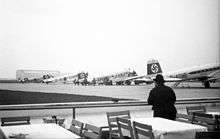
On the northern part of the airport originated in 1935 a two-storey station building with a six-storey tower, and other operating and outbuildings for maintenance and storage of aircraft. The approximately 100 hectares runway received a grass cover.
The official opening of the new Flug- und Luftschiffhafen Rhein-Main took place on July 8, 1936. The first plane that landed was a Ju 52/3m, Six days later, on 14 July 1936 LZ 127 Graf Zeppelin landed at the airport. 1936 800 tons of cargo and 58,000 passengers were transported, in 1937 70,000 passengers and 966 tons of cargo. In the coming years, the new airport was home base of the two largest German airships LZ 127 Graf Zeppelin and LZ 129 Hindenburg . In 1938 Frankfurt was a central distribution point for the transport of airmail to North America.
On May 6, 1937, it came to a serious accident: The Hindenburg , on the way from Frankfurt to New York, exploded shortly before application in the landing area of Lakehurst, 36 people died. The accident marked the end of the regular air shipping traffic and the end of the era of airships.
World War II
After the beginning of World War II in 1939 all foreign airlines left the airport and control of air traffic was transferred to the Luftwaffe. On 9 May 1940, the first bombers took off to attack France. From August to November 1944 a concentration camp was established in Walldorf, close to the airport site, where Jewish female prisoners were forced to work for the airport. The Allies of World War II destroyed the runway system with airstrikes in 1944 and the Wehrmacht blew up buildings and fuel depots in 1945, shortly before the US Army took control of the airport on 25 March 1945. After the German Instrument of Surrender the war in Europe ended and the US Army started to build a new temporary runway at Frankfurt Airport. The southern part of the airport ground was occupied to build the Rhein-Main Air Base as an Air Force Base for the United States Air Forces in Europe.
Berlin Airlift
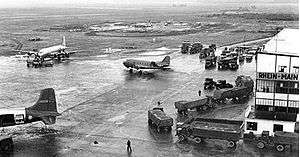
In 1948 the Soviet Union blocked the Western Allies' rail and road access to the sectors of West Berlin under Allied control. Their aim was to force the western powers to allow the Soviet zone to start supplying Berlin with food and fuel, thereby giving the Soviets practical control over the entire city. In response, the Western Allies organised the Berlin Airlift to carry supplies via air to the people in West Berlin. The airports in Frankfurt, Hamburg and Hannover were the primary bases for Allied aircraft. The heavy use of these so-called "Raisin Bombers" caused damage to the runway in Frankfurt and forced the US Army to build a second parallel runway. The airlift ended in September 1949 after the Soviet Union ended their blockade.
Growth of the airport
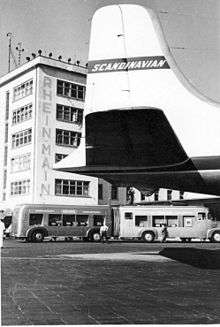
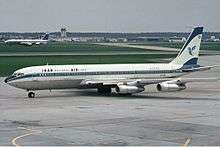
In 1951 restrictions for German air travellers were lifted and civil air traffic started to grow again. In 1952 Frankfurt Airport handled more than 400,000 passengers; a year later it was more than half a million. About 100 to 120 aeroplanes took off from and landed in Frankfurt daily. In 1955, Lufthansa resumed flights to and from Frankfurt and in the same year the Federal Republic of Germany gained its air sovereignty back from the Allies. In 1957 the northern runway was extended, first to 3,000 m (9,843 ft) and then to 3,900 m (12,795 ft), to make it compatible with jet aircraft.
The airport did not emerge as a major international airline hub until 1958 when a new passenger terminal called Empfangsanlage Ost (Terminal East, literally "Arrival Facility East") opened in the north-east corner of the airport site. Only four years later it was clear that the terminal was already too small for the demand. In 1961 Frankfurt already had 2.2 million passengers and 81,000 take-offs and landings, making it the second busiest airport in Europe behind London Heathrow Airport.
In 1962 it was decided to build an even larger terminal with a capacity of 30 million passengers per year. Work on this terminal began in 1965. The southern runway was extended to 3,750 m (12,303 ft) in 1964. In 1970 a new hangar was inaugurated; this accommodated six jet aircraft and was the world's largest hangar at the time.
The new main terminal
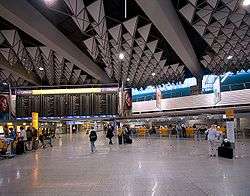
The new terminal, called Terminal Mitte (Central Terminal, today known as Terminal 1) is divided into three concourses (A, B and C) with 56 gates and an electric baggage handling system. Everything opened to the public on 14 March 1972. It was assumed that the terminal capacity would be sufficient for the next 30 years. Along with the new terminal a railway station (Frankfurt Airport station) was opened, the first airport railway station in the Federal Republic of Germany. A few days later the old Empfangsanlage Ost was closed.
The third runway
Planning for a third runway (called Startbahn 18 West) began in 1973. This project spawned massive protests by residents and environmentalists. The main points of conflict were increasing noise and pollution and the cutting down of protected trees in the Frankfurt City Forest. While the protests and related lawsuits were unsuccessful in preventing the construction of the runway, the Startbahn West protests were one of the major crystallisation points for the German environmental movement of the 1980s. The protests even continued after the runway had been opened in 1984 and in 1987 two police officers were killed by a gunman. This incident ended the Startbahn West protests for good. Because of its orientation in the north–south direction, in contrast to the other two runways which run east–west, the use of the third runway is limited. The Startbahn West can only be used for takeoffs to the south because otherwise they would interfere with air traffic at the other runways. Due to this restriction the runway must be partially or fully closed when northward winds are too strong.
Terminal 2 and the second railway station
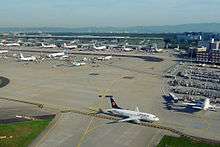
In 1990, work on a new terminal (Terminal 2) began because it was anticipated that Terminal Mitte would reach its capacity limit sooner than expected. The new terminal, divided into concourses D and E, was built to the east of the existing terminal where once the Empfangsanlage Ost had been. With its opening in 1994, Frankfurt Airport increased its terminal capacity to 54 million passengers per year. Along with the terminal opening, a people mover system called Sky Line was established to provide a fast connection between Terminal 2 and Terminal Mitte (now renamed Terminal 1).
In 1999 a second railway station, primarily for InterCityExpress long-distance trains (called Frankfurt Airport long-distance station), opened near Terminal 1 as part of the new Cologne–Frankfurt high-speed rail line. At the same time local and regional rail services were based at the existing underground station, now renamed Frankfurt Airport regional station.
Closure of the Rhein-Main Air Base
On 30 December 2005, the Rhein-Main Air Base in the southern part of the airport ground was closed and the US Air Force moved to Ramstein Air Base. The property was handed back to Fraport which allows the airport to use it to build a new passenger terminal. The property of the housing area for the soldiers, called Gateway Gardens, which was located north-east of the airport site, was given back to the city of Frankfurt in the same year and will be developed as a business district in the following years.
The Airbus A380 and The Squaire
From 2005 to 2007 a large Airbus A380 maintenance facility was built at Frankfurt Airport because Lufthansa wanted to station their future A380 aircraft fleet there. Due to economic constraints only half of the facility has been built so far. Both terminals also underwent major renovations in order to handle the A380, including the installation of a third boarding bridge at several gates. Lufthansa's first Airbus A380 went into operation in June 2010 and was named Frankfurt am Main.
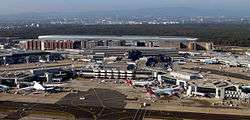
In 2011 a large office building called The Squaire (a portmanteau of square and air) opened at Frankfurt Airport. It was built on top of the Airport long-distance station and is considered the largest office building in Germany with 140,000 m2 (1,500,000 sq ft) floor area. Main tenants are KPMG and two Hilton Hotels.
Since 2012 the people mover "The Squaire Metro" connects the Squaire with the nine-story parking structure. On a length of about 300 meters the so-called MiniMetro system with its two cabins can carry up to 1,300 passengers per hour.[8] The constructor of the system was the Italian manufacturer Leitner.
The fourth runway
Plans to build a fourth runway at Frankfurt Airport had been under-way since 1997 but, due to the violent conflicts with the building of the third runway, Fraport let residents' groups and environmentalists participate in the process to find a mutually acceptable solution. In 2000, a task force presented their conclusion which generally approved a new runway, but in shorter length (only 2.8 kilometres compared to the other three 4-kilometre-long runways) which would serve as a landing-only runway for smaller aircraft. Additional requirements included improved noise protection arrangements and a strict ban on night flights between 11 pm and 5 am across the whole airport. In 2001, Fraport applied for an approval to build a new runway, with three possible variants assessed. This concluded that a runway north-west of the airport site would have the least impact on local residents and the surrounding environment. The plans were approved by the Hessian government in December 2007, but the requested ban on night flights was lifted because it was argued that an international airport like Frankfurt would need night flights, especially for worldwide freight transport. Construction of the new 2,800 m (9,186 ft) long Runway Northwest in the Kelsterbach Forest began in early 2009.
Developments since 2011
The new runway officially went into operation on 20 October 2011, with an aircraft carrying Chancellor Angela Merkel performing the first landing on 21 October. The centre line separation from the existing north runway is about 1,400 m (4,593 ft). This allows simultaneous instrument landing system (ILS) operations on these two runways, which has not been possible on the other parallel runways, which do not meet the 3,500-foot minimum separation for ILS operations.[9] This allowed the airport to increase its capacity from 83 to 126 aircraft movements per hour.[10][11]
On 11 October 2011, the Hessian Administration Court ruled that night flights between 11pm and 5am (the so-called Mediationsnacht) are no longer allowed at Frankfurt Airport after the inauguration of the new runway, and therefore over-rode the approval from the Hessian government from 2007 which allowed 17 scheduled flights per night. On 4 April 2012 the German Administrative Court confirmed the decision of the Hessian Administration Court, banning night flights between 11pm and 5am.[12]
To handle the predicted passenger amount of about 90 million in 2020, a new terminal section adjacent to Terminal 1 for an additional six million passengers opened on 10 October 2012. It is called Flugsteig A-Plus and exclusively used by Lufthansa mainly for their long-haul flights. Flugsteig A-Plus features eight parking positions and is able to handle four Airbus A380 or seven Boeing 747 at once.[13]
In November 2016, Ryanair announced to open a new base at Frankfurt Airport starting four routes to Spain and Portugal. This sparked severe criticism especially from Lufthansa as Ryanair was granted high discounts and incentives regarding the airport's fees.[14]
Facilities
Terminals
Frankfurt Airport has two large main passenger terminals (1 and 2) and a much smaller dedicated First Class Terminal which is operated and exclusively used by Lufthansa. As is the case at London's Heathrow Airport, terminal operations are grouped for airlines and airline alliances rather than into domestic and international routes.
Terminal 1

Terminal 1 is the older and larger one of the two passenger terminals. The landside is 420 metres long. It has been enlarged several times and is divided into concourses A, B, C and Z and has a capacity of approximately 50 million passengers per year. Terminal 1 is functionally divided into three levels, the departures level on the upper floor with check-in counters, the arrivals level with baggage claim areas on the ground floor and, underneath, a distribution floor with access to the regional station and underground and multilevel parking. Departures and arrivals levels each have separate street approaches. A bus station is located at arrivals level. Terminal 1 has a total of 103 gates, which include 54 gates equipped with jetways (25 in Concourse A, 18 in Concourse B, 11 in Concourse C).
Pier A was extended by 500 metres in 2000, and a link between Terminal 1 and Terminal 2, as well as the Hall C extension opened in 2008.[15]
On 10 October 2012, an 800-metre-long westward expansion of Terminal 1 called Pier A-Plus went into operation. It provides more stands for wide-body aircraft like the Airbus A380.[16]
Terminal 1 is primarily used by Lufthansa, its associated companies (Brussels Airlines, Eurowings, Swiss International Air Lines and Austrian Airlines) and its Star Alliance partners (e.g. Aegean Airlines, Air Canada, Air China, Air India, All Nippon Airways, Croatia Airlines, Scandinavian Airlines, Singapore Airlines, South African Airways, TAP Portugal, Thai Airways, Turkish Airlines and United Airlines).
Terminal 2
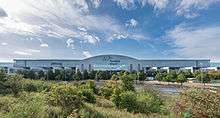
Terminal 2, which has a capacity of 15 million passengers a year, was opened in 1994 and is divided into concourses D and E. A continuous concourse between Terminal 1C and 2D provides direct, but non-public access between the two terminals. It has eight gates with jetways and 34 apron stands, a total of 42 gates and is able to handle wide-body aircraft such as Korean Air's Airbus A380s.
Terminal 2 is primarily used by airlines of the oneworld (e.g. Air Berlin, American Airlines, British Airways, Cathay Pacific, Finnair, Iberia, Japan Airlines, LAN Airlines, Malaysia Airlines, Royal Jordanian and S7 Airlines) and SkyTeam alliances (e.g. Aeroflot, Air France, Alitalia, China Airlines, China Eastern Airlines, Czech Airlines, Delta Air Lines, KLM Royal Dutch Airlines, Korean Air, Saudia, TAROM and Vietnam Airlines).
Passengers and visitors can change terminals with the people mover system SkyLine which has stops at Terminal 1 AZ (passengers only), Terminal 1 BC and Terminal 2 DE. The travel time between the terminals is 2 minutes with trains arriving every 2–3 minutes during the day. Additionally there is regular bus service between the terminals. The future of terminal 2 will operate also for Star Alliance Lufthansa for the next 2020.
Lufthansa First Class Terminal
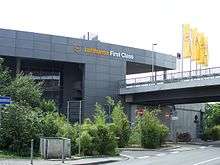
Lufthansa operates a small dedicated First Class Terminal near Terminal 1 with exclusive access for Lufthansa first class passengers and HON Circle frequent flyer members only. Other first class passengers must use the dedicated first class lounges within the main terminals. The facility has 200 staff and is used by about 300 passengers daily. It provides individualised security screening and customs facilities. Amenities include valet parking, a white-linen restaurant, lounge and office areas, a cigar room and bubble baths. Passengers are transported directly from the terminal to the plane by luxury car.
Runways
Frankfurt Airport has four runways of which three are arranged parallel in east–west direction and one in north–south direction. In 2010 three runways (Runways North, South and West) handled 464,432 aircraft movements, which equated to 83 movements per hour. With the start of operation of the Northwest Runway in October 2011 the airport was predicted to be able to handle 126 movements per hour. It is predicted that aircraft movements will increase up to 700,000 in the year 2020. By using the fourth runway, Frankfurt Airport is able for the first time to handle simultaneous parallel landings, because the distance between the north and the north-west runways is 1,400 m (4,593 ft). Simultaneous parallel landings were not possible with the north and south runway pairing, because the separation distance did not meet the safety standard prescribed by the International Civil Aviation Organization.
| Direction/name | Length in m / ft | Surface | Arrangement | Start of operation | Use |
|---|---|---|---|---|---|
| 07C/25C (Runway North) | 4000 × 60 / 13,123 × 197 | Asphalt | East-west | 1936 | Take-offs (landings allowed) |
| 07R/25L (Runway South) | 4000 × 45 / 13,123 × 148 | Asphalt | East-west | 1949 | Take-offs and landings |
| 18 (Runway West) | 4000 × 45 / 13,123 × 148 | Concrete | North-south | 1984 | Take-offs in southbound direction only |
| 07L/25R (Runway Northwest) | 2800 × 45 / 9,240 × 148 | Concrete | East-west | 2011 | Landings only (not allowed for Airbus A380, Boeing 747, MD-11) |
During normal operation the two outer parallel runways (07L/25R and 07R/25L) are used for landings and the central parallel runway (07C/25C) and the Runway West (18) for take-offs. The three parallel runways have two markings because they can be operated in two directions while the Runway West can only be used in one direction.
Future expansions
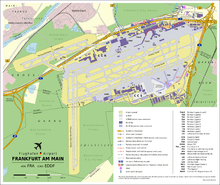
Terminal 3 (under construction)
In 2009, the German government decided to create third terminals for both Frankfurt Airport and Munich Airport, in order to handle expected passenger flows of 90 million in Frankfurt by 2020 and 50 million in Munich by 2017. The new terminal is scheduled to be built by Fraport, south of the existing terminals on the grounds of the former Rhein-Main Air Base. The new Terminal 3 is to accommodate up to 25 million passengers and will feature 75 new aircraft positions when completely constructed. An extension of the SkyLine people mover system is planned to connect the new terminal to Terminals 1 and 2 and the airport train stations.
In August 2014, the city of Frankfurt granted building permission for the first phase of Terminal 3.[17] The groundbreaking for the new Terminal took place on 5 October 2015. Its first phase, consisting of the main building and two of the planned four piers, is planned to open by 2022 and will be able to handle 15 million additional passengers per year. Total costs are estimated at 3 billion Euros.[18]
Passenger airlines and destinations
106 airlines fly to 275 destinations in 111 countries from Frankfurt Airport, with approximately 1,365 flights per day. Lufthansa and their Star Alliance partners account for 77% of all passengers at Frankfurt Airport.[19] 65% of all intercontinental flights in Germany are operated at Frankfurt Airport, followed by Munich Airport with 17%.[19]
Due to capacity constraints until autumn 2011 when the fourth runway went into operation, there are few low-cost carriers operating at Frankfurt Airport. These airlines use Frankfurt–Hahn Airport as an alternative which also provides lower operational costs. Despite its name, Frankfurt–Hahn Airport is located about 120 km (75 mi) west of Frankfurt, closer to Koblenz and Mainz.
The following airlines offer regular scheduled and charter flights at Frankfurt Airport:[20]
Cargo airlines and destinations
Frankfurt Airport is the second-largest multimodal transport airport in Europe and has several logistics facilities. These facilities are grouped at two areas at the airport ground: In the north (CargoCity Nord) and in the south (CargoCity Süd). In 2010 it was the second-busiest airport by cargo traffic in Europe after Paris–Charles de Gaulle Airport, handling 2,231,348 metric tonnes of loaded and unloaded freight.
The following airlines operate regular scheduled cargo operations at Frankfurt Airport:
CargoCity
CargoCity is the name of the two large main areas featuring most of the airport's freight handling facilities:
- The 98 hectare large CargoCity Süd (South) is home to a cargo centre for dispatch service providers and freight forwarding businesses. Several transport companies like DHL Global Forwarding, Air China, Emirates, Japan Airlines, Cathay Pacific, Korean Air and Fraport Cargo Services are based here.
- CargoCity Nord (North) is the headquarters of Lufthansa Cargo. Additional facilities here are a Perishables Centre for fresh produced goods and the Frankfurt Animal Lounge for the transport of living animals.
Other facilities
Airport City

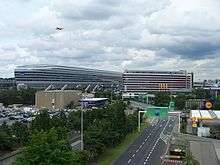
The airport ground and the surrounding area of Frankfurt Airport offer a large variety of on-airport businesses as well as airport-related businesses, including office space, hotels, shopping areas, conference rooms and car parks. The development of an airport city has significantly accelerated in recent years.
Frankfurt Airport Centres
The Frankfurt Airport Centre 1 (FAC 1) near Terminal 1 offers office and conference facilities, the newer FAC 2 is located within Terminal 2 and offers office space for airlines.
Airport City Mall
The Airport City Mall is located on the landside of Terminal 1, departure hall B. It offers national and international retailers and label stores, a supermarket and several restaurants.
The Squaire
The Squaire is an office building with a total floor area of 140,000 m2 (1,506,900 sq ft). It is directly connected to Terminal 1 through a connecting corridor for pedestrians. The accounting firm KPMG, Lufthansa and two Hilton Hotels (Hilton Garden Inn Frankfurt Airport with 334 rooms and Hilton Frankfurt Airport with 249 rooms) occupy space in The Squaire.
Main Airport Centre
The Main Airport Centre, named after the Main river, is an office building with ten floors and about 51,000 m2 (549,000 sq ft) of office space. It is located at the edge of the Frankfurt City Forest near Terminal 2.
Sheraton Hotel & Conference Centre
Sheraton Hotels and Resorts offers 1,008 guest rooms adjacent to Terminal 1 and a conference centre for up to 200 delegates.
Gateway Gardens
Gateway Gardens is a former housing area for the United States Air Force personnel based at the Rhein-Main Air Base, close to Terminal 2. Like the air base, the housing area was closed in 2005. Since then the area is being developed into a business location for airport-related companies. Lufthansa moved its airline catering subsidiary LSG Sky Chefs to Gateway Gardens, Condor and SunExpress are headquartered here. DB Schenker, the logistics company of Deutsche Bahn, is currently building a 66 m (217 ft) high-rise building.
Further users

- Fraport's facilities are on the property of Frankfurt Airport.[42] Its head office building is by Gate 3.[43] The newly constructed[44] headquarters were inaugurated there in 2012.[45] The Fraport Driving School (Fraport Fahrschule) is in Building 501 of CargoCity South (CargoCity Süd).[46][47]
- Lufthansa's main building, where the board of directors is seated, is called Lufthansa Aviation Centre (LAC).[48] Lufthansa operates the Lufthansa Aviation Center (LAC), Building 366 at Frankfurt Airport.[49][50] Several company departments, including Corporate Communications,[51] Investor Relations,[52] and Media Relations,[53] are based at the LAC. Lufthansa also uses several other buildings in the area, including the Lufthansa Flight Training Center for flight training operations and the Lufthansa Basis BG2[54] as a central base and for crew briefing. As of 2011 Lufthansa Cargo has been headquartered in Building 451 of the Frankfurt Airport area.[55] As of 2012 Lufthansa Cargo is located at Gate 25 in the CargoCity Nord area, Lufthansa Technik is located at Gate 23 and in the CargoCity Süd area.[56]
- Star Alliance, an airline alliance, is headquartered at the Frankfurt Airport Centre 1 (FAC 1) adjacent to Terminal 1.[57]
- Airmail Centre Frankfurt, a joint venture of Lufthansa Cargo, Fraport, and Deutsche Post for airmail transport, has its head office in Building 189, between Terminals 1 and 2.[58]
- Transaero Airlines had its European head office in Building 151.[59]
- Aero Lloyd previously had its head office in Building 182.[60][61]
Statistics
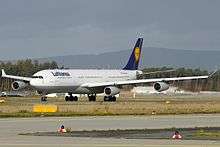
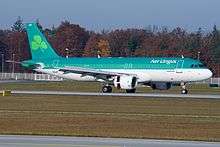
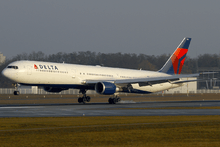
.jpg)
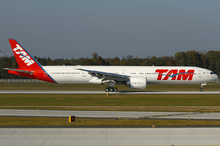
%2C_Germany_PP1375032230.jpg)


Passenger numbers
| Passengers | ||||
|---|---|---|---|---|
| 2000 | 49,360,620 | |||
| 2001 | | |||
| 2002 | | |||
| 2003 | | |||
| 2004 | | |||
| 2005 | | |||
| 2006 | | |||
| 2007 | | |||
| 2008 | | |||
| 2009 | | |||
| 2010 | | |||
| 2011 | | |||
| 2012 | | |||
| 2013 | | |||
| 2014[62] | | |||
| 2015[1] | | |||
| Source: ADV[63] | ||||
Route statistics
| Rank | Destination | Departing passengers | Operating airlines |
|---|---|---|---|
| 1 | Berlin–Tegel | 802,000 | Lufthansa, Air Berlin |
| 2 | Hamburg | 745,100 | Lufthansa |
| 3 | London–Heathrow | 639,500 | British Airways, Lufthansa |
| 4 | Zurich | 621,070 | Lufthansa, Swiss International Air Lines |
| 5 | Vienna | 484,200 | Austrian Airlines, Lufthansa |
| 6 | Munich | 475,100 | Lufthansa |
| 7 | Madrid | 459,400 | Iberia, LAN Airlines, Lufthansa, Air Europa |
| 8 | Chicago–O'Hare | 451,700 | Lufthansa, United Airlines |
| 9 | Paris–Charles de Gaulle | 448,200 | Air France, Lufthansa |
| 10 | Singapore | 429,500 | Lufthansa, Singapore Airlines |
| 11 | New York–JFK | 365,400 | Delta, Lufthansa, Singapore Airlines |
| 12 | Geneva | 386,556 | Lufthansa |
| 13 | Dubai | 337,700 | Emirates, Lufthansa |
| 14 | Washington–Dulles | 334,900 | Lufthansa, United Airlines |
| 15 | Bangkok–Suvarnabhumi | 330,900 | Lufthansa, Thai Airways |
| 16 | Rome–Fiumicino | 320,300 | Alitalia, Lufthansa |
| 17 | Istanbul–Atatürk | 319,900 | Lufthansa, Turkish Airlines |
| 18 | Palma de Mallorca | 319,000 | Air Berlin, Condor, TUIfly, Lufthansa |
| 19 | Barcelona | 290,600 | Lufthansa, Vueling |
| 20 | Tokyo–Narita | 290,600 | All Nippon Airways, Japan Airlines, Lufthansa |
| 21 | Toronto–Pearson | 289,100 | Air Canada, Lufthansa, Condor |
| 22 | Antalya | 289,000 | Condor, Pegasus Airlines, SunExpress, TUIFly, Turkish Airlines |
| 23 | Amsterdam | 287,200 | KLM, Lufthansa |
| 24 | San Francisco | 277,300 | Lufthansa, United Airlines |
| 25 | Copenhagen | 276,400 | Lufthansa, Scandinavian Airlines |
| 26 | Beijing–Capital | 270,500 | Air China, Lufthansa |
| 27 | Shanghai–Pudong | 264,900 | Air China, China Eastern Airlines, Lufthansa |
| 28 | Stockholm–Arlanda | 264,000 | Lufthansa, Scandinavian Airlines |
| 29 | Newark | 255,000 | United Airlines, Lufthansa |
| 30 | Lisbon | 253,900 | Lufthansa, TAP Portugal |
| 31 | Seoul–Incheon | 236,400 | Asiana Airlines, Korean Air, Lufthansa |
| 32 | Tel Aviv | 228,300 | El Al, Lufthansa, Sun d'Or International Airlines |
| 33 | São Paulo–Guarulhos | 223,500 | Lufthansa, TAM Airlines |
| 34 | Helsinki | 222,700 | Finnair, Lufthansa |
| 35 | Hong Kong | 221,700 | Cathay Pacific, Lufthansa |
| 36 | Prague | 220,000 | Czech Airlines, Lufthansa |
| 37 | Dublin | 214,700 | Aer Lingus, Lufthansa |
| 38 | Oslo–Gardermoen | 213,300 | Lufthansa, Scandinavian Airlines |
| 39 | Athens | 210,500 | Aegean Airlines, Lufthansa |
| 40 | Moscow–Domodedovo | 210,500 | Lufthansa |
Ground transport
Frankfurt Airport can easily be accessed by car, taxi, train or bus as it features an extensive transport network. There are two railway stations at the airport: one for suburban/regional trains and one for long-distance trains.
Rail
Regional station
_Flughafen_Regionalbahnhof-_auf_Bahnsteig_zu_Gleis_3-_S-Bahn_Rhein-Main_420_227-8_18.10.2009.jpg)
Frankfurt Airport regional station (Frankfurt Flughafen Regionalbahnhof) at Terminal 1, concourse B, provides access to the S-Bahn commuter rail lines S8 and S9. Each of these lines have trains departing every 15 minutes during daytime to Hanau Central Station eastwards via Frankfurt Central Station and Offenbach East Station or Wiesbaden Central Station westwards via Rüsselsheim or Mainz Central Station (line S8) or Mainz-Kastel Station (line S9).
The journey time to Frankfurt Central Station is 10–12 minutes.[65]
Regional Express (RE) trains to Saarbrücken, Koblenz or Würzburg call at this station. These trains provide less frequent but additional connections between Frankfurt Airport and the Central Station.[65]
Long-distance station
Frankfurt Airport long-distance station (Frankfurt Flughafen Fernbahnhof) was opened in 1999. The station is squeezed in between the motorway A 3 and the four-lane Bundesstraße B43, linked to Terminal 1 by a connecting corridor for pedestrians that bridges the Autobahn. It is the end point of the newly built Cologne–Frankfurt high-speed rail line, which links southern Germany to the Rhine-Ruhr metropolitan area, the Netherlands and Belgium via Cologne at speeds up to 300 km/h (190 mph). About 10 trains per hour depart in all directions.[65]
Deutsche Bahn operates the AIRail Service in conjunction with Lufthansa, American Airlines and Emirates. The service operates to the central stations of Bonn, Cologne, Düsseldorf, Freiburg, Karlsruhe, Leipzig, Hamburg, Hannover, Mannheim, Munich, Nuremberg, Stuttgart and to Kassel-Wilhelmshöhe.[66]
Car
Frankfurt Airport is located in the Frankfurt City Forest and directly connected to an Autobahn intersection called Frankfurter Kreuz where the A3 and A5 meet. It takes a 10–15 minutes by car or taxi to get to Frankfurt Central Station or the centre of the city.[67]
Passengers driving their own cars can park in multilevel parking garages (mostly underground) along the terminals. A long term holiday parking lot is located south of the runways and connected by shuttle bus to the terminals.
Bus and coaches
Various transport companies provide bus services to the airport from the surrounding areas as well as by coach to long-distance destinations.[68]
Previously All Nippon Airways operated a bus service to Düsseldorf exclusively for ANA customers; that way Düsseldorf passengers would be transported to Frankfurt Airport to board their ANA flights.[69] In 2014 ANA established a separate flight from Tokyo to Düsseldorf,[70] causing the bus services to end.[71]
Ground transport statistics
In 2006, 29.5% of the 12,299,192 passengers whose air travel originated in Frankfurt came by private car, 27.9% came by rail, 20.4% by taxi, 11.1% parked their car at the airport for the duration of their trip, 5.3% came by bus, and 4.6% arrived with a rental car.[72]
Incidents and accidents
- On 22 May 1983 during an Air show at Rhein-Main Air Base, a Canadian RCAF Lockheed F-104 Starfighter crashed into a nearby road, hitting a car and killing all passengers, a vicar's family of five. The pilot was able to eject.
- On 19 June 1985 a bomb cloaked in a canvas bag was detonated approx at 14:42 in the afternoon in Hall B of the Rhein Main Frankfurt Airport, leaving the section to look like a battlefield. The blast resulted in 3 deaths and 32 injuries, of which 4 were considered serious.[73]
- In September 2007, German authorities arrested three suspected terrorists for plotting a "massive" terror attack, which posed "an imminent threat" to Frankfurt Airport and the US Air Force base in Ramstein.[74]
- On 2 March 2011, a gunman opened fire on a bus carrying US Air Force personnel at Frankfurt Airport, killing two and wounding two others.[75]
In media
Frankfurt Airport is featured in the Discovery Channel series X-Ray Mega Airport (also known as Inside Frankfurt Airport).[76]
See also
- Transport in Germany
- List of airports in Germany
- Deutsche Zeppelin Reederei
- Horst Julius Freiherr Treusch von Buttlar-Brandenfels
- Rhein-Main Air Base
- Fraport
- The Squaire
References
- 1 2 figures/2016/traffic-fugures-dez-2015/jcr:content.file/traffic_sheet_2015_december.pdf Fraport Group Traffic Figures
- ↑ "Frankfurt airport – Economic and social impact". Ecquants. Retrieved 7 September 2013.
- ↑ "Traffic Figures". Retrieved 24 January 2013.
- 1 2 "EAD Basic". Ead.eurocontrol.int. Retrieved 19 January 2012.
- ↑ "Figures". Fraport.de. 13 January 2012. Retrieved 19 January 2012.
- ↑ "Year to date". Retrieved 2 June 2015.
- ↑ "2015 Facts and Figures on Frankfurt Airport - Fraport" (PDF). Germany: Fraport.com. Retrieved 6 September 2016.
- ↑ "The Squaire Metro".
- ↑ Archived 20 April 2006 at the Wayback Machine.
- ↑ Rahn, Cornelius (5 August 2010). "Air Berlin Urged to Switch Focus to FRA". Bloomberg.com. Retrieved 19 January 2012.
- ↑ Fraport AG Airport Services World Wide. "Fraport AG - Expansion projects". Retrieved 2 June 2015.
- ↑ Urteil im Fluglärm-Prozess Keine Nachtflüge mehr am Flughafen Frankfurt, retrieved 4 April 2012
- ↑ Fraport AG Airport Services World Wide. "Fraport AG - Flugsteig A-Plus". Retrieved 2 June 2015.
- ↑ http://www.aero.de/news-25349/Ryanair-startet-ab-Maerz-in-Frankfurt.html
- ↑ "2012 Facts and Figures on Frankfurt Airport" (PDF). Fraport. p. 4. Retrieved 10 July 2014.
- ↑ "Fraport AG | en". Fraport.com. 31 May 2013. Retrieved 21 June 2013.
- ↑ Friederike Tinnappel,. "Flughafen Frankfurt: Terminal 3 darf gebaut werden". Retrieved 2 June 2015.
- ↑ aero.de - Frankfurt beginnt mit Bauarbeiten für Terminal 3 "Frankfurt starts construction of Terminal 3" (German) 5 October 2015
- 1 2 "Fraport Visual Fact Book Full Year 2011" (PDF). Fraport AG. Retrieved 24 June 2012.
- ↑ Fraport AG. "Frankfurt Airport - Arrivals". Retrieved 2 June 2015.
- ↑ "Air Canada to launch Vancouver-Frankfurt and Vancouver-London Gatwick flights for Summer 2017". Canadian Aviation News. Retrieved 9 November 2016.
- ↑ "Condor adds Comiso service in S17". routesonline. Retrieved 18 November 2016.
- 1 2 "Condor Adds New Orleans / San Diego Service in S17". Airline Route. 8 June 2016. Retrieved 8 June 2016.
- ↑ http://www.routesonline.com/news/38/airlineroute/269772/condor-schedules-pittsburgh-seasonal-launch-in-june-2017/
- ↑ http://www.routesonline.com/news/38/airlineroute/267472/condor-adds-porto-santo-service-in-s17/
- ↑ http://www.routesonline.com/news/38/airlineroute/267718/condor-adds-new-greek-routes-in-s17/
- ↑ http://el.ellinair.com/
- ↑ http://www.aero.de/news-24197/Lufthansa-fliegt-wieder-von-Frankfurt-nach-Kapstadt.html
- ↑ "Lufthansa suspends Tokyo Narita service in 1Q17". routesonline. Retrieved 8 November 2016.
- ↑ http://www.routesonline.com/news/38/airlineroute/269934/lufthansa-s17-european-routes-additions/
- ↑ http://www.routesonline.com/news/38/airlineroute/269934/lufthansa-s17-european-routes-additions/
- ↑ https://www.finavia.fi/en/news-room/news/2016/tourists-intrigued-by-magical-lapland-lufthansa-introduces-yet-another-connection-to-the-north/
- ↑ http://www.routesonline.com/news/38/airlineroute/269934/lufthansa-s17-european-routes-additions/
- ↑ "Lufthansa announces new Shannon-Frankfurt route". RTÉ. 16 November 2016. Retrieved 16 November 2016.
- ↑ http://www.routesonline.com/news/38/airlineroute/270002/lufthansa-adds-frankfurt-paderborn-in-s17/
- ↑ http://corporate.ryanair.com/news/news/161102-new-frankfurt-am-main-base-no-85-to-open/?market=en#sthash.1VV3OXHV.dpuf
- ↑ "AeroLogic Adds New Hong Kong Routing in W14". Retrieved 2 June 2015.
- 1 2 http://www.aircargoworld.com/Air-Cargo-News/2013/07/china-southern-begins-guangzhou-frankfurt-freighter-service/2514640
- ↑ Emirates SkyCargo Schedule
- ↑ Etihad Crystal Cargo Schedule
- ↑ "2013 summer schedule". Aero Logic. Retrieved 13 August 2013.
- ↑ "How to find us." Fraport. Retrieved on 28 May 2011.
- ↑ "Offering of 22,700,000 Ordinary Bearer Shares of Fraport AG Frankfurt Airport Services Worldwide." Fraport. H-4. Retrieved on 28 May 2011. "REGISTERED AND HEAD OFFICE OF THE COMPANY Fraport AG Frankfurt Airport Services Worldwide Flughafen Tor 3 60547 Frankfurt am Main Germany"
- ↑ "Quality breeds Success." Fraport. Retrieved on 28 May 2011.
- ↑ "Connecting Sustainably Report 2010." Fraport. 35. Retrieved on 28 May 2011.
- ↑ "Fraport Driving School How to find us!." Fraport. Retrieved on 28 May 2011.
- ↑ "Fraport Fahrschule So finden Sie uns." Fraport. Retrieved on 28 May 2011.
- ↑ http://lac.lufthansa.com/de/index.php
- ↑ "How to get there." Lufthansa Aviation Center. Retrieved on 28 May 2011.
- ↑ "Imprint." Lufthansa Aviation Center. Retrieved on 15 November 2012. "Gebäude 366 Airportring 60546 Frankfurt/Main"
- ↑ "Service Contact Person." Lufthansa. Retrieved on 15 February 2010.
- ↑ "Contacts Investor Relations." Lufthansa. Retrieved on 14 February 2010.
- ↑ "Media Relations." Lufthansa. Retrieved on 14 February 2010.
- ↑ "Lufthansa Basis BG2". feest.com.de. Retrieved 2 June 2015.
- ↑ "Imprint." Lufthansa Cargo. Retrieved on 28 May 2011. "Lufthansa Cargo AG Flughafenbereich West Tor 25, Gebäude 451 D-60546 Frankfurt am Main"
- ↑ https://www.lufthansa-technik.com/documents/100446/183272/General+Contact+Sheet+140208.pdf
- ↑ "."Star Alliance. Retrieved on 12 December 2013. "Star Alliance Services GmbH Frankfurt Airport Centre, Main Lobby 60546 Frankfurt/Main."
- ↑ "Airmail Center Frankfurt GmbH (ACF)." Fraport. Retrieved on 28 May 2011. "Contact: Airmail Center Frankfurt GmbH Flughafen Frankfurt Tor 3, Gebäude 189 Postfach 750164 60549 Frankfurt am Main Germany"
- ↑ "Ticket Sales Offices." Transaero. Retrieved on 13 November 2012. "Transaero Airlines, Head office in Europe Geb. 151 HBK 096 Flughafen D-60549 Frankfurt am Main."
- ↑ "World Airline Directory." Flight International. 16 May 1981. 1391. "Luftverkehrs KG, Gebäude 182, Flughafen, 6,000 Frankfurt, West Germany" - Direct PDF Link, Archive
- ↑ "World airline directory." Flight International. 26 July 1980. p. 262. Direct PDF link (Archive) "Flughafen Frankfurt Rheim-Main, West Germany"
- ↑ Fraport AG Airport Services World Wide. "Fraport AG - Fraport-Verkehrszahlen 2014: Mehr Passagiere und Fracht in Frankfurt trotz zahlreicher Streiktage". Retrieved 2 June 2015.
- ↑ Flughafenverband ADV. "Flughafenverband ADV – Unsere Flughäfen: Regionale Stärke, Globaler Anschluss". Retrieved 2 June 2015.
- ↑ DeStatis: Luftverkehr auf allen Flugplätzen 2015, Chapters 4+5
- 1 2 3 Fraport AG. "Frankfurt Airport - Bus & Bahn". Retrieved 2 June 2015.
- ↑ Fraport AG. "Frankfurt Airport - Frankfurt Airport - AIRail Service". Retrieved 2 June 2015.
- ↑ Fraport AG. "Frankfurt Airport - Auto". Retrieved 2 June 2015.
- ↑ Fraport AG. "Frankfurt Airport - Frankfurt Airport - Bushaltestellen". Retrieved 2 June 2015.
- ↑ "ANA Shuttle-Bus" (Archive). All Nippon Airways. Retrieved on October 29, 2016.
- ↑ "ANA kommt täglich nach Düsseldorf". Flug Revue. 2013-12-18. Retrieved 2016-09-27.
- ↑ "Yokoso! All Nippon Airways (ANA) to Offer Daily Connection between Düsseldorf and Tokyo Starting March 30." Press release from ANA at the website of convention bureau DÜSSELDORF. Retrieved on October 26, 2016.
- ↑ Statistical data prepared by Fraport department MVG-MF based on polls conducted in the departure lounges every four days
- ↑ Times Wire Service (19 June 1985). "Frankfurt Airport Ripped by Bomb; 3 Killed, 32 Hurt : Explosive Put in Trash Can by Ticket Counters". Los Angeles Times. Retrieved 1 May 2013.
- ↑ 'Massive' Terror Plot Foiled In Germany (Sky News)
- ↑ "Frankfurt Airport shooting: Two US servicemen dead". BBC News. 2 March 2011. Retrieved 2 March 2011.
- ↑ White, Peter (2 December 2014). "Discovery jets to Frankfurt airport". Broadcastnow.co.uk. Archived from the original on 15 July 2015. Retrieved 15 July 2015.
External links
![]() Frankfurt Airport travel guide from Wikivoyage
Frankfurt Airport travel guide from Wikivoyage
![]() Media related to Frankfurt Airport at Wikimedia Commons
Media related to Frankfurt Airport at Wikimedia Commons
- Official website
- Current weather for EDDF at NOAA/NWS
- Accident history for FRA at Aviation Safety Network